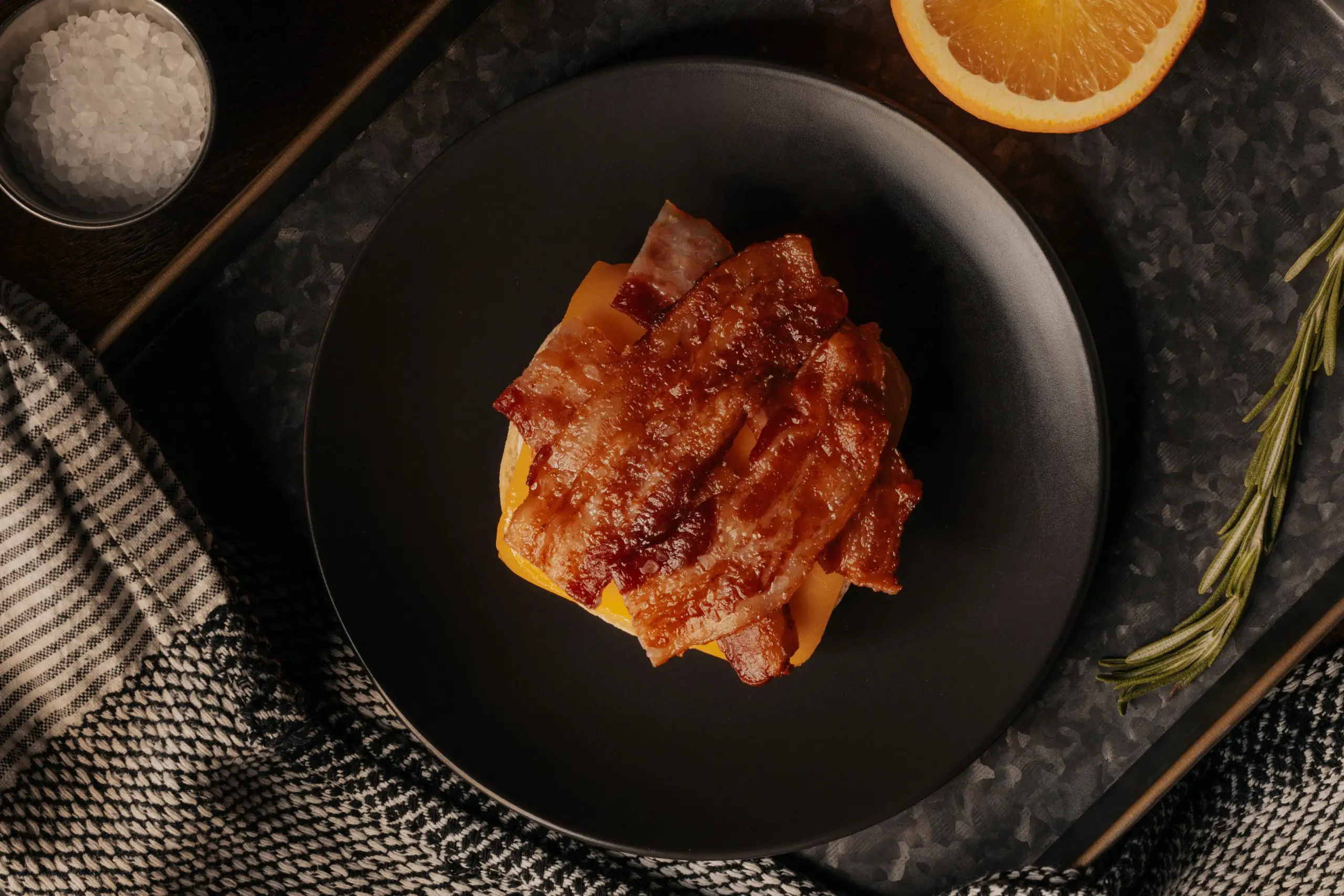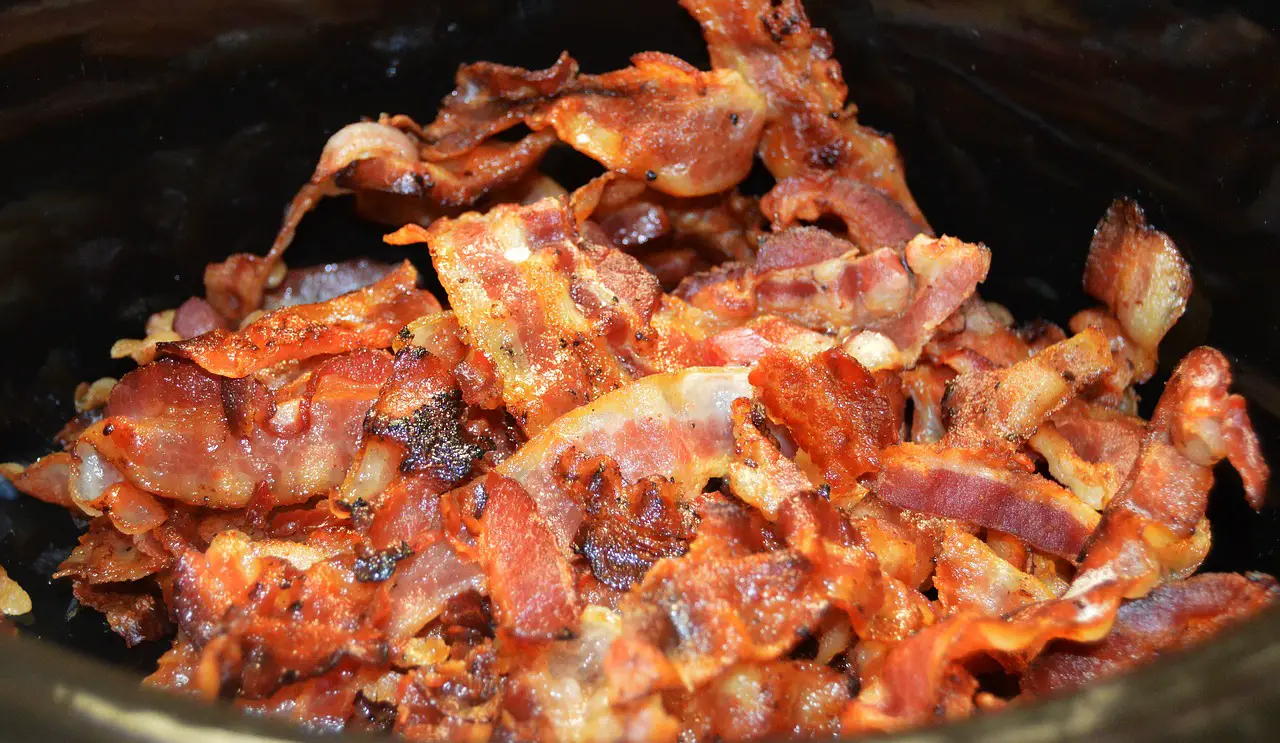Bacon is a popular breakfast food that is often enjoyed with eggs, toast, and coffee. It’s delicious, but it can be a hassle to cook, especially if you’re making it for a large group of people. However, you should know some details about this method before attempting it.
One way to save time and effort is to cook bacon in advance and reheat it when you’re ready to eat. But is it safe to reheat bacon in the microwave? In this article, we’ll explore the pros and cons of reheating bacon in the microwave and provide some tips for doing it safely. So let’s get started!

Can you Reheat Bacon in the Microwave?
Yes, bacon can be reheated in the microwave. However, doing so safely is essential to avoid undercooking or to overcook the bacon and potentially cause foodborne illness. When reheating bacon in the microwave, use a microwave-safe plate and cover it with a paper towel to soak up any excess grease.
It is best to use the microwave’s lowest power setting and reheat the bacon for the shortest time possible. Microwave the bacon in set intervals, checking and turning the strips over frequently until they reach a safe internal temperature of at least 165 degrees Fahrenheit. It’s also important to keep an eye on the texture of the bacon after it’s been reheated because it can become tough or rubbery if overcooked.
What is the Best Method for Reheating Bacon?
The desired outcome and the available equipment confirm the best way to reheat bacon. Baking in the oven, cooking on the stovetop, or microwaving are all options. The microwave is convenient and quick but can result in a softer texture.
The oven is ideal for large amounts of bacon. It helps to retain the crispy texture, whereas the stovetop is ideal for small amounts because it allows for more control over the level of crispiness. Finally, personal preference and available resources will determine the best method.
Method 1. Using the Stovetop to Reheat Bacon
To prevent the bacon from burning or becoming overcooked, keep an eye on it as it cooks. You can cook the bacon for a shorter period if you prefer a softer texture. You can cook it for a little longer if you prefer a crisper texture. Ensure that the internal temperature of the bacon has reached a safe temperature of at least 165 degrees Fahrenheit. Follow these steps to reheat bacon on the stovetop:
- Heat a pan over medium heat.
- Add the bacon slices to the pan.
- Cook for a few minutes on every side or until the bacon is heated through and reaches your desired level of crispiness.
- Remove the bacon from the pan and place it on a plate lined with paper towels to absorb any excess grease.
- Let the bacon cool for a few minutes before serving.
Method 2. Using an Oven to Reheat Bacon
If you have a large amount of bacon to reheat or want to keep the crispy texture, baking it in the oven is a good option. Ensure that the internal temperature of the bacon has reached a safe temperature of at least 165 degrees Fahrenheit. Keep an eye on the bacon as it bakes to prevent it from burning. To reheat bacon in the oven, follow these steps:
- Preheat your oven to 350 degrees Fahrenheit.
- Put the bacon on a baking sheet lined with parchment paper or a silicone mat.
- Bake the bacon for about 10 minutes or until it reaches your desired level of crispiness.
- Detech the bacon from the oven and place it on a plate lined with paper towels to absorb any excess grease.
- Allow the bacon to cool slightly before serving.
Method 3. Using the Microwave to Reheat Bacon
The bacon can be quickly and easily microwaved, but it could have a softer texture than other techniques. Pay attention to the texture of the bacon after reheating and prevent overcooking it because it could turn tough or rubbery.
Additionally crucial are using a microwave-safe plate and covering the bacon with a paper towel to soak up extra grease. To reheat bacon in the microwave, follow these steps:
- Put the bacon on a platter that can be heated in the microwave, and then wrap it in a paper towel to soak up any extra grease.
- The bacon should be heated to a safe internal temperature of at least 165 degrees Fahrenheit in the microwave in short bursts, with frequent checking and turning off the strips.
- The bacon should be removed from the microwave and put on a dish covered with paper towels to absorb any extra fat.
- Allow the bacon to cool for a few minutes before serving.
Is it Safe to Reheat Cooked Bacon?
Yes, reheating cooked bacon is generally safe as long as it is done properly to ensure it reaches a safe internal temperature. To ensure the bacon is safe to eat, it is crucial to use a food thermometer to check the internal temperature of the meat before serving. To kill any potential bacteria or pathogens that may have been introduced during storage, bacon should be reheated to at least 165 degrees Fahrenheit.
Additionally, it’s critical to adhere to the correct food safety precautions, which include using clean utensils and surfaces, storing the bacon appropriately, and preventing the bacon from being exposed to temperatures in the “danger zone” (between 40 and 140 degrees Fahrenheit) for an extended period. You can safely eat your leftover bacon if you keep to these laws.
Is it Better to Microwave Bacon than Fry it?
Microwaving bacon is only sometimes preferable to frying it. Finally, the best method for cooking bacon is determined by your personal preferences and the time and resources you have available. Both methods can produce tasty bacon but have different advantages and disadvantages.
Microwaving bacon is generally faster and easier than frying it because no pan or oil is required. On the other hand, microwave bacon may not be as crispy as fried bacon and may lack the savory, caramelized flavors that come with frying. Furthermore, microwaving bacon can result in uneven results because some pieces may cook faster than others.
Frying bacon in a pan or on a grill allows you to control the temperature and cooking time, which can help you achieve a more consistent texture and flavor. However, microwaving is more messy and time-consuming than frying bacon, producing more splatters and smoke. Furthermore, frying bacon can add extra calories and fat to your diet due to the added oil.
How can you Know if your Bacon has Gone Bad?
To keep bacon from spoiling, handling and storing it correctly is necessary. Always keep the bacon refrigerated until ready to cook, and cook it to an internal temperature of 145°F to ensure it is safe to eat. There are several indicators that bacon has gone bad:
- Examine the package’s expiration date. Bacon has a one-week shelf life in the refrigerator and up to six months in the freezer.
- If the bacon is past its expiration date, it will likely be spoiled.
- Check the color and texture of the bacon. Fresh bacon should be pink with white fat, and it should be relatively firm to the touch.
- If the bacon is brown or gray, or if it is soft or slimy to the touch, it is probably spoiled.
- Fresh bacon should have a slightly salty and smoky smell. It is probably spoiled if the bacon has a strong, sour, or rotten smell.
- Cook and taste a small piece of the bacon. If it tastes off or has a strange texture, it is probably spoiled and should be discarded.
What Happens if you Eat Spoiled Bacon?
Eating spoiled bacon can result in food poisoning, which is an illness caused by consuming contaminated food or drinks. Food poisoning symptoms include nausea, vomiting, diarrhea, stomach cramps, fever, and dehydration. These symptoms can be mild to severe and can last a few days.
In severe cases, food poisoning can lead to hospitalization or even death. It is important to handle and store bacon properly to prevent it from becoming spoiled. Bacon should be stored in the refrigerator at 40 degrees Fahrenheit or lower or in the freezer at 0 degrees Fahrenheit or lower.
The bacon is probably rotten and should not be eaten if it smells sour or odd or has a slimy or sticky texture. It’s crucial to get medical help immediately if you believe you may have consumed tainted bacon. The signs of food poisoning can be severe, so it’s critical to get medical attention right once to avoid further issues.
What is the Shelf Life of Bacon?
The shelf life of bacon depends on how it is stored. It is important to note that the shelf life of bacon can be affected by several factors, such as the humidity and temperature of the storage environment and the quality of the bacon itself. Here is a summary of the shelf life of bacon in different storage conditions:
- In the refrigerator (below 40°F or four °C): Up to 1 week after the package has been opened, or up to 2 weeks if the bacon is sealed in its original packaging and has not been opened.
- In the freezer (below 0°F or -18°C): Up to 6 months if the bacon is stored in an airtight container or wrapped in aluminum foil or plastic wrap to prevent freezer burn.
- At room temperature (above 40°F or four °C): Bacon should not be stored at room temperature for an extended period, as it can quickly become spoiled due to the growth of bacteria. If the bacon is left out at room temperature for more than 2 hours, it is best to discard it.
Conclusion
To summarise, reheating bacon in the microwave is safe if proper precautions are taken to avoid undercooking or to overcook the meat. You can successfully reheat your bacon without sacrificing taste or safety by using a microwave-safe plate, covering it with a paper towel, and reheating it in short intervals at a low-power setting.
Just be sure to check the internal temperature of the bacon to ensure that it has reached a safe temperature, and be mindful of the texture, as overcooked bacon can become tough or rubbery. Following these guidelines, you can safely reheat bacon in the microwave and enjoy a tasty, convenient breakfast or snack.
